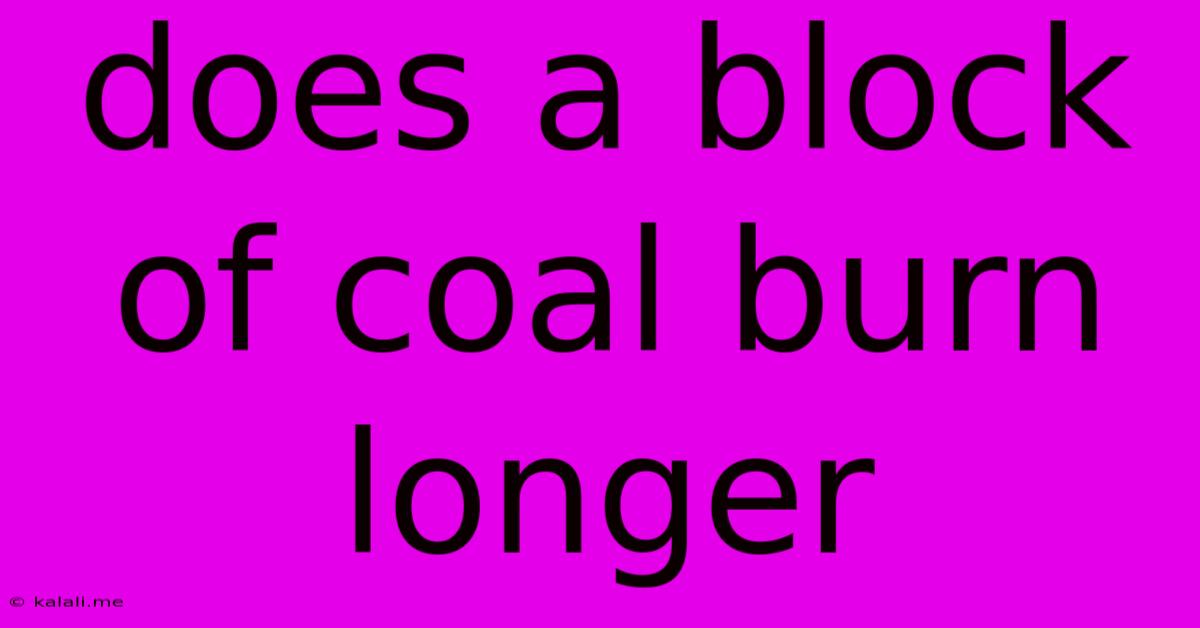Does A Block Of Coal Burn Longer
Kalali
Jun 07, 2025 · 3 min read

Table of Contents
Does a Block of Coal Burn Longer Than Smaller Pieces? A Deep Dive into Coal Combustion
This article explores the burning time of coal, comparing a large block to smaller pieces. We'll delve into the science behind combustion, considering factors beyond just size that influence burn duration. Understanding these factors is crucial for optimizing coal usage, whether for historical context, scientific experiments, or even specialized industrial applications.
The Seemingly Simple Question: Size Matters, But How?
Intuitively, you might assume a large block of coal burns longer than smaller pieces. After all, it contains more coal, right? While this is partially true, the relationship isn't as straightforward as it seems. The burn time is affected by several interacting factors:
Surface Area to Volume Ratio: The Key Player
The critical factor influencing burn time isn't just the total mass of coal but the surface area exposed to oxygen. A large block has a smaller surface area relative to its volume compared to smaller pieces. This means less coal is directly exposed to the air needed for combustion. Smaller pieces, on the other hand, have a much higher surface area to volume ratio, leading to a faster burn rate.
Think of it like this: imagine trying to light a log versus a pile of kindling. The kindling, with its high surface area, catches fire and burns quickly. The log, despite containing more wood, takes longer to ignite and burn due to its smaller surface area.
Other Factors Influencing Coal Burn Time
Besides size and surface area, several other factors influence how long a piece of coal burns:
- Coal Type: Different types of coal (anthracite, bituminous, lignite) have varying densities, moisture content, and volatile matter, all influencing their combustion characteristics. Anthracite, for example, is a denser, harder coal that burns slower and hotter than lignite.
- Oxygen Supply: Sufficient oxygen is essential for combustion. Restricting airflow will significantly lengthen the burn time, but it might also lead to incomplete combustion, producing more smoke and less heat.
- Moisture Content: Wet coal will burn slower than dry coal as some of the heat energy is used to evaporate the water.
- Ambient Temperature: Higher ambient temperatures can accelerate the burn rate.
- Presence of Impurities: Impurities within the coal can affect the burn rate and the overall efficiency of combustion.
The Verdict: It's Complicated
While a larger block of coal does contain more fuel, its lower surface area to volume ratio often results in a slower overall burn time compared to the same mass of coal broken into smaller pieces. The smaller pieces burn more quickly due to increased oxygen exposure. The total burn time will also depend on the other factors discussed above. Therefore, simply comparing the size of the coal doesn't provide a complete picture. A comprehensive understanding of coal combustion requires considering all influencing variables.
Conclusion: The duration of coal combustion is a complex interplay of several factors. While the sheer mass of coal influences the total energy released, the surface area available for oxidation ultimately determines how quickly that energy is released. Therefore, smaller pieces of coal, despite having less total mass, often burn faster than a single larger block of the same total mass.
Latest Posts
Latest Posts
-
How Long Does A Basil Plant Live
Jun 07, 2025
-
Mac Cannot Switch After Installing Windows
Jun 07, 2025
-
Best Way To Attach Piers For Deck
Jun 07, 2025
-
How To Adjust Pressure Reducing Valve
Jun 07, 2025
-
What Can I Use As A Lubricant For Bike Chain
Jun 07, 2025
Related Post
Thank you for visiting our website which covers about Does A Block Of Coal Burn Longer . We hope the information provided has been useful to you. Feel free to contact us if you have any questions or need further assistance. See you next time and don't miss to bookmark.